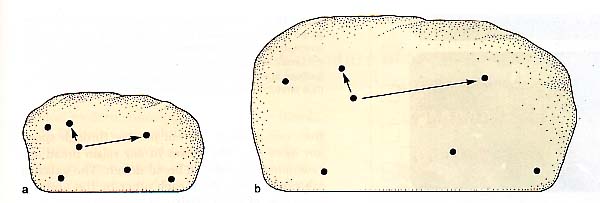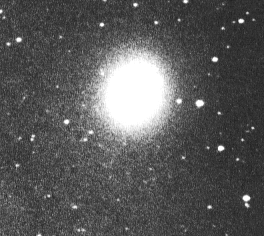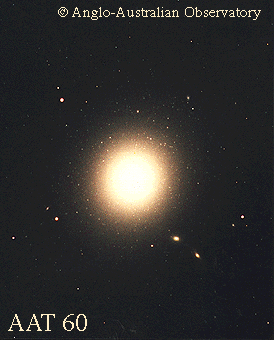Cepheid Variables
We mentioned earlier that
some stars are variable stars. Some stars change their brightness
due to pulsations, in which they alternately grow and shrink in size, over
a few days' time. One kind is the Cepheid variables, which are luminous
red supergiant stars that are burning helium in a shell around their cores.
Low-mass stars in this stage have thermal pulses in which they lose most
of their mass as a planetary nebula, but the high-mass stars have a thick
enough layer of gas that the pulses do not eject the outer layers.
Instead, the outer layers alternately expand and contract, making the star
get brighter and dimmer over their cycle.
It turns out that Cepheid
variables have a very remarkable and useful property. Their period
of pulsation varies with their luminosity. If we measure two things
about a distant Cepheid variable, 1) its apparent brightness, and 2) its
period, then we can combine these to determine its distance. Luckily,
Cepheid variables are among the brightest of stars, so we can actually
detect them in other galaxies!
See this
very thorough lecture about Cepheids and the distance to the Large
Magellanic Cloud.
Hubble's Law
The Hubble Space Telescope
is named after Edwin Hubble, who was the first to use Cepheid variables
(in 1924) to measure the distance to the nearest spiral galaxy, the Andromeda
Galaxy. Prior to his measurement of the distance to Andromeda Galaxy,
we had no way of knowing how far away it was. In Hubble's time, the
1920's, there was a debate about whether "spiral nebulae" were clouds of
gas, or collections of stars. Using the largest telescope in the
world at that time, the 100-inch telescope on Mt. Wilson, CA, Hubble took
photographs of the galaxy over many days, and discovered several Cepheid
variables. By measuring their periods and their apparent brightnesses,
he showed for the first time that the Andromeda Galaxy is at a great distance--more
than 2 million light years!
Even more than this, Hubble
went on to measure Cepheid variables in several other galaxies as well.
As part of his analysis, he measured both the distance to the galaxies
and their doppler shifts. He made one of the most remarkable discoveries
in science -- that more distant galaxies have a larger redshift.
This has become known as the Hubble Redshift Law,
or Hubble's Law, and it holds true
throughout the universe. The farther away a galaxy is, the larger
its redshift. Recall that light is redshifted when objects move away
from the observer. What this is telling us is that the universe
is expanding! The constant of proportionality between
distance and redshift is called the Hubble Constant, designated Ho.
Using this constant, we can tell the distance to the most distant objects
we can measure! All we do is measure its spectrum, determine how
much the spectral lines are redshifted, convert that to a velocity v,
called the recessional velocity, and
from the equation v = Hod,
we can get its distance.
But we have two practical
difficulties that we must solve in order to use this to determine accurate
distances.
-
Galaxies do not obey Hubble's
Law exactly, because they have velocities of their own, in addition to
their recessional velocity. This is especially problematic for nearby
galaxies, whose recessional velocities are small compared to their own
velocities.
-
Even when galaxies do obey Hubble's
Law, the distance we measure is only as accurate as the value of Ho.
For many many years it was not known to better than a factor of two--somewhere
between 50 and 100 km s-1
Mpc-1.
Hubble could measure the constant
Ho,
but it was not very accurate because it was based on those galaxies within
reach of the Cepheid distance-scale. One of the key
projects of the Hubble Space Telescope was to pin down the value of
with much better than the factor of two accuracy it has had for so long.
The final results of this key project are in, and the announced value is
Ho
~ 72 +/- 8 km s-1
Mpc-1.
We will discuss the implications
of the expansion of the universe in a moment, but first, let's take a look
at the complete distance scale. We discussed this when we talked
about parallax measurements of nearby stars, which was one link in the
chain. Here is the entire chain:
Complete Chain of Distance
Scale
-
Radar to measure distance to
planets => determination of the value of 1 Astronomical Unit. The
value can be used to measure distances within our solar system.
-
Parallax to measure distance
to nearby stars => determination of the value of 1 pc. Parallax can
be measured for stars within about 100 pc of the Sun.
-
Main-sequence fitting to measure
distance to clusters => determination of the distance to clusters of stars
within the galaxy. This is good for measuring distances out to about
50 kpc, within our galaxy and the Magellanic Clouds (our satellite galaxies).
-
Cepheid variables to measure
distance to nearby galaxies => good to about 10 Mpc
-
Other distance standards (e.g. Tulley-Fisher Relation) =>
good to 100 Mpc?
-
Hubble's Law => good to any
distance
-
Type Ia supernovae => good to
any distance
Recall that the
more distant an object is, the longer it takes for the light to reach us.
Thus, we see distant objects as they were in the past, not as they are
now. For example, it takes 8 minutes for the light from the Sun to
reach Earth, so we see the Sun as it was 8 minutes earlier. We see
alpha Centauri (at a distance of 4.3 light years) as it was 4.3 years ago.
And we see the Andromeda Galaxy as it appeared 2 million years ago.
As we look farther and farther
into the distance, we are also looking further and further into the past.
This would be true even for a static universe, but Hubble's discovery that
the universe is expanding makes things even stranger.
We can think of the expansion
of the universe as if the galaxies are painted on the surface of an expanding
balloon, or better, as if they were raisins in an expanding loaf of raisin
bread.

 The expansion of the universe
is the expansion of space itself, not a motion
through space. Nearby galaxies appear to move more slowly
away, because there is not much space between us and them, but more distant
galaxies appear to move more quickly because there is more space separating
us from them. Note that it does not matter which raisin in the bread,
or which dot on the balloon, we choose. All of the raisins and dots
move away from all of the others.
The expansion of the universe
is the expansion of space itself, not a motion
through space. Nearby galaxies appear to move more slowly
away, because there is not much space between us and them, but more distant
galaxies appear to move more quickly because there is more space separating
us from them. Note that it does not matter which raisin in the bread,
or which dot on the balloon, we choose. All of the raisins and dots
move away from all of the others.
But notice that if all of
the galaxies are moving away from all of the others due to the expansion
of the universe, it is obvious that if we ran the clock backwards the galaxies
would all get closer together. In fact, if we keep running the clock
backward, Hubble's Constant tells us when the galaxies would all come together
in a single point. Notice the units of Hubble's Constant -- km
s-1
Mpc-1.
Both km and Mpc are units of distance, and we could express them in the
same units, e.g. km, and cancel them. Thus, the remaining units are
inverse time (s-1).
So inverting Hubble's Constant must give us a time, in seconds. The
inverse of 72 km s-1
Mpc-1
turns out to correspond to about 14 billion years. This is why we
said in the very first lecture that the age of the universe is 14 billion
years. This is the length of time that the universe has been expanding.
Now, following what we said
earlier, if the universe is only 14 billion years old, can we see galaxies
as far away as 14 billion light years? If so, we would be seeing
all the way back in time to the beginning of the universe -- back to the
Big Bang itself. Obviously, we cannot see back beyond the beginning
of the universe, so there is a horizon beyond which we cannot see -- the
Cosmological
Horizon. But what about Hubble's Law. Since the
universe is expanding, perhaps the galaxies near 14 billion light years
away are moving near the speed of light. In fact, this is the case,
and there are galaxies so far away that they appear to be moving faster
than the speed of light relative to us. Note that we talked about
Special Relativity, and the impossibility of anything to move faster than
the speed of light through space. But what we are talking about here
is not motion through space -- it is the expansion of space itself.
There is no speed limit on the expansion of space. So the observable
universe has a horizon that we cannot see beyond -- not because it is too
far back in time, but because it is moving away so fast that light from
beyond it can never reach us.



